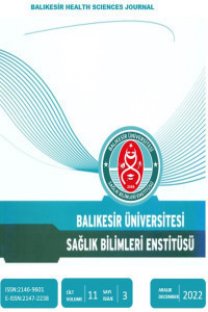Human Papilloma Virüs Enfeksiyonu ve Aşısı Konusunda İki Farklı Öğretim Tekniğinin Hemşirelik Öğrencilerinin Sosyal Kaygı ve e-Öğrenme Tutumlarına Etkisi
The Effects of Two Different Teaching Techniques on Human Papilloma Virus Infection and Vaccine on Nursing Students’ Social Anxiety and e-Learning Attitudes
___
- Anderson, J. S., & Williams, S. K. (2012). Pecha Kucha for lean and sticky presentations in business classes. Northern Arizona University–The WA Franke College of Business–Working Paper Series-12, 3.
- Bakcek, O., Tastan, S., Iyigun, E., Kurtoglu, P., & Tastan, B. (2020). Comparison of PechaKucha and traditional PowerPoint presentations in nursing education: A randomized controlled study. Nurse education in practice, 42, 102695.
- Baltacı, Ö., & Hamarta, E. (2013). Analyzing the relationship between social anxiety, social support and problem solving approach of university students.
- Behrens, F., & Kret, M. E. (2019). The interplay between face-to-face contact and feedback on cooperation during real-life interactions. Journal of Nonverbal Behavior, 43(4), 513-528.
- Beyer, A. M. (2011). Improving student presentations: Pecha Kucha and just plain PowerPoint. Teaching of Psychology, 38(2), 122-126.
- Buchko, A. A., Buchko, K. J., & Meyer, J. M. (2012). Is there power in PowerPoint? A field test of the efficacy of PowerPoint on memory and recall of religious sermons. Computers in Human Behavior, 28(2), 688-695.
- Byrne, M. M. (2016). Presentation innovations: using Pecha Kucha in nursing education. Teaching and Learning in Nursing, 11(1), 20-22.
- Cangöl, E., Sögüt, S., Süt, H. K., & Küçükkaya, B. (2019). Knowledge and attitudes of nursing students concerning HPV vaccination. Journal of Human Sciences, 16(1), 1-12.
- Carroll, A. J., Tchangalova, N., & Harrington, E. G. (2016). Flipping one-shot library instruction: using Canvas and Pecha Kucha for peer teaching. Journal of the Medical Library Association: JMLA, 104(2), 125.
- Ceyhan, M. (2012). Human papillomavirus (HPV) vaccines. Journal of Clinical Development, 25, 36-39.
- Çelik, A. (2012). The effect of data matrix supported mobile learning environment on active vocabulary learning in foreign language learning and student opinions: Mobile dictionary example. Unpublished Master’s thesis, Graduate Schoold of Educational Sciences). Gazi University, Ankara.
- Dağ, H., Dönmez, S., Sezer, H., Şendağ, F., Sevil, Ü., & Saruhan, A. (2015). The effects of two different teaching techniques on the knowledge level of nursing students about HPV. Gaziantep Medical Journal, 21(2), 90-98.
- Demir, K., & Akpınar, E. (2016). An attitude scale development study towards mobile learning. Educational Technology Theory and Practice, 6(1), 59-79.
- Erbaydar, N., Çilingiroğlu, N., Keskin, C., Altunbaş, M., Arslanoğlu, E., Aydin, O., . . . Gündüz, G. G. (2016). What Does the Human Papilloma Virus Vaccine Mean for Nurses at a University Hospital? Journal of Hacettepe University Faculty of Nursing, 3(3), 16-27.
- Harmanci, H., Dayioğlu, H., & Kirkpinar, S. N. (2019). Investigation of the Relationship between University Students' Social Media Addiction and Fear of Positive Evaluation and Fear of Negative Evaluation. Karatay Journal of Social Studies, (3), 242-255.
- Ingram, N., Williamson-Leadley, S., & Pratt, K. (2016). Showing and telling: using tablet technology to engage students in mathematics. Mathematics Education Research Journal, 28(1), 123-147.
- Keskin, S., Şahin, M., Uluç, S., & Yurdugul, H. (2020). Online learners’ interactions and social anxiety: The social anxiety scale for e-learning environments (SASE). Interactive Learning Environments, 1-13.
- Kim, H. (2018). Impact of slide-based lectures on undergraduate students’ learning: Mixed effects of accessibility to slides, differences in note-taking, and memory term. Computers & Education, 123, 13-25.
- Korucu, A. T., Ertuğrul, U., & Çoklar, A. N. (2019). Attitudes of education faculty and tourism faculty students towards mobile learning. Journal of Theoretical Educational Science, 12(1), 1-15.
- Levin, M. A., & Peterson, L. T. (2013). Use of Pecha Kucha in marketing students' presentations. Marketing Education Review, 23(1), 59-64.
- Masters, J. C., & Holland, B. E. (2012). Rescuing the student presentation with Pecha Kucha. Journal of Nursing Education, 51(9), 536-536.
- Murray, T. A. (2013). Innovations in nursing education: The state of the art. Journal of Nursing Regulation, 3(4), 25-31.
- Murugaiah, P. (2016). Pecha Kucha style PowerPoint presentation: An innovative CALL approach to developing oral presentation skills of tertiary students. Teaching english with technology, 16(1), 88-104.
- Nielsen, A. E., Noone, J., Voss, H., & Mathews, L. R. (2013). Preparing nursing students for the future: An innovative approach to clinical education. Nurse education in practice, 13(4), 301-309.
- Oliver, J., & Kowalczyk, C. (2013). Improving student group marketing presentations: A modified Pecha Kucha approach. Marketing Education Review, 23(1), 55-58.
- Ozan, Ö. (2013). Scaffolding in Connectivist mobile learning environments. Unpublished doctoral thesis. Eskisehir: Anadolu University.
- Robb, M. K. (2012). Managing a large class environment: Simple strategies for new nurse educators. Teaching and Learning in Nursing, 7(2), 47-50.
- Savoy, A., Proctor, R. W., & Salvendy, G. (2009). Information retention from PowerPoint™ and traditional lectures. Computers & Education, 52(4), 858-867.
- Warmuth, K. A., & Caple, A. H. (2021). Differences in Instructor, Presenter, and Audience Ratings of PechaKucha and Traditional Student Presentations. Teaching of Psychology, 00986283211006389.
- Yen, J.-Y., Yen, C.-F., Chen, C.-S., Wang, P.-W., Chang, Y.-H., & Ko, C.-H. (2012). Social anxiety in online and real-life interaction and their associated factors. Cyberpsychology, Behavior, and Social Networking, 15(1), 7-12.
- ISSN: 2146-9601
- Yayın Aralığı: Yılda 3 Sayı
- Yayıncı: BALIKESİR ÜNİVERSİTESİ
Furkan BİLEK, Caner Feyzi DEMİR
Benlik Saygısının Hemşirelerin Mutluluk, Yaşam Doyumu ve Umutsuzluk Düzeylerine Yordayıcı Etkisi
Burçin IŞIK, Nurgül ÖZDEMİR, Burcu ÇAKI
Merve Aliye AKYOL, Burcu AKPINAR SÖYLEMEZ, Ecem ÖZGÜL, Özlem KÜÇÜKGÜÇLÜ
Serdar BOZYEL, Onur ARGAN, Kadriye HALLI AKAY, Eyup AVCI, Tuncay KIRIS
Serap KAYNAK, Yasemin YILDIRIM, Zehra Çiçek FADILOĞLU, Fisun ŞENUZUN AYKAR
İnternetteki Sağlık Bilgileri Güvenilir Mi? Evde Ateş Yönetimi ile İlgili Bir Çalışma
Figen Işık ESENAY, Gülçin KORKMAZ YENİCE
Sıçanlarda İndometazin ile İndüklenen Mide Ülseri Üzerine Badem ve Elma Yağının Koruyucu Etkileri
Özlem AYDIN BERKTAŞ, Fadime ATALAY DUMLU
Seyhan ÇANKAYA, Cevriye OCAKTAN
Fertilite Sağlığı Bilgi Ölçeği’nin Türkçeye Uyarlanması: Geçerlik ve Güvenirlik Çalışması
Erkek Cinsiyetine Yönelik Kalıpyargılar Ölçeği’ni Türkçe’ye Uyarlama Çalışması: Metodolojik Çalışma
